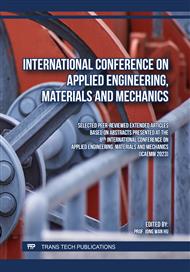[1]
Albornoz, Y. (Marzo de 2014). Soil and Pavement Laboratory. Merida, Merida, Venezuela: Andes University.
Google Scholar
[2]
Asphalt Institute. (1997). Asphalt cold mix. Lexington: Asphalt Institute.
Google Scholar
[3]
Búa, M. T. (30 de abril de 2014). Stone Materials. Retrieved from: https://www.edu.xunta.gal/espazoAbalar/sites/espazoAbalar/files/datos/1464947174/contido/61_materiales_ptreos.html
Google Scholar
[4]
Cajas, V. X., & Iglesias , A. G. (January 2nd, 2010). Use of steel slag for the improvement of cold asphalt mixtures. Obtenido de http://repositorio.puce.edu.ec/bitstream/handle/22000/3594/T-PUCE-3604.pdf?sequence=1
Google Scholar
[5]
Carlos Preciado, C. S. (2013). Use of Waste Fibers from Industrial Processes as a Stabilizer for Asphalt Mixtures. Retrieved from: https://repository.javeriana.edu.co/bitstream/handle/10554/21465/PreciadoBolivarCarlosAlberto2013.pdf?sequence=1&isAllowed=y
Google Scholar
[6]
Clarín. (2018). The initiative aims to end the incineration of paper. El Clarin.
Google Scholar
[7]
Data Commons. (July 7th, 2021). South American country. Retrieved from: https://datacommons.org/place/country/ECU
Google Scholar
[8]
Garnica Anguas, P., Delgado Alamilla, H., Gómez López, J. A., Romero, S. A., & Alarcón Orta, H.A. (2004). Aspects of Volumetric Design of Asphalt Mixtures. Retrieved from: https://www.imt.mx/archivos/publicaciones/publicaciontecnica/pt246.pdf
Google Scholar
[9]
I.N.V.E. (2007). Granulometric Analysis of Coarse Aggregates. I.N.V.E-213-07.
Google Scholar
[10]
INEC. (2019). Final tabs GIRS 2019. Retrieved from: https://www.ecuadorencifras.gob.ec/documentos/web-inec/Encuestas_Ambientales/ Municipios_2019/Residuos_solidos_2019/Tabulados%20Finales%20GIRS%202019.xlsx: INEC.
Google Scholar
[11]
INEN. (2013). Asphalt Emulsions. Determination of Residue by Evaporation. Quito,Pichincha, Ecuador: INEN.
Google Scholar
[12]
INEN. (2013). Petroleum Products. Determination of Saybolt Viscosity. Retrieved from: https://www.normalizacion.gob.ec/buzon/normas/1981-1.pdf
Google Scholar
[13]
León, P. J., & Herrera, V. R. (March, 2019). Characterization of aggregates from two mines for the design of hot asphalt mix that meet MTOP specifications. Retrieved from: http://www.dspace.uce.edu.ec/bitstream/25000/18434/1/T-UCE-0012-FIG-002%20-%20P.pdf
Google Scholar
[14]
MTOP. (12 de 2015). National Strategic Plan for Ciclovías. Quito, Pichincha, Ecuador.
Google Scholar
[15]
NTE-INEN 863. (29 de junio de 2011). Arid. Determination of the Solidity of Aggregates Using Sodium Sulfate or Magnesium Sulfate. Retrieved from: https://www.normalizacion.gob.ec/buzon/normas/863.pdf
Google Scholar
[16]
Paul , G., Horacio , D., & Carlos Daniel Sandoval Sandoval, S. (2005). Comparative Analysis of the Marshall and Superpave Methods for Compaction of Asphalt Mixtures. Retrieved from: https://www.imt.mx/archivos/Publicaciones/PublicacionTecnica/pt271.pdf
Google Scholar
[17]
Reyes, F. (2013). Behavior of an Asphalt Cement Modified with a Residue of PVC. Revista Ingenierías Universidad de Medellín. 75-84.
Google Scholar
[18]
Rodriguez, R., Castaño, V. M., & Martinez , M. (March 3rd, 2010). Asphalt Emulsions. Retrieved from: https://www.imt.mx/archivos/publicaciones/documentotecnico/dt23.pdf
Google Scholar
[19]
Sánchez, F. (February 6th, 2021). Geotech tips. Retrieved from: Breve historia del polígono de vacíos.: https://www.geotechtips.com/post/breve-historia-del-pol%C3%ADgono-de-vac%C3%ADos
Google Scholar
[20]
Vera. (12 de Agosto de 2016). Design manual for bicycle lane infrastructure. San Luis, Perú.
Google Scholar
[21]
VISE. (2021). Characteristics of Hot and Cold Asphalt Mixtures. Retrieved from: https://blog.vise.com.mx/caracteristicas-de-las-mezclas-asfalticas-en-frio-y-caliente
Google Scholar
[22]
Zúñiga, R. (June, 2015). National Highway Laboratory. Retrieved from: http://www.vialidad.cl/areasdevialidad/laboratorionacional/MaterialCursos/Mezclas%20Asf%C3%A1lticas.pdf
Google Scholar



